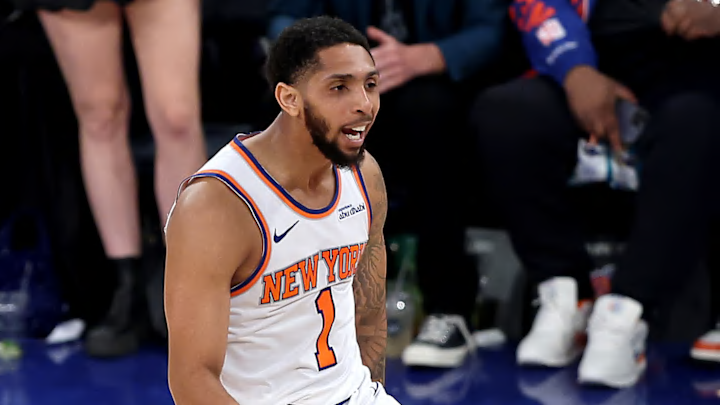Cam Payne just saved the New York Knicks' season.
That is not an overstatement, unless you imply that he did it alone. He didn't. OG Anunoby, Karl-Anthony Towns, Jalen Brunson, Mitchell Robinson, and even head coach Tom Thibodeau proved instrumental in steering the Knicks away from a massive Game 1 letdown on Saturday night against the Detroit Pistons. New York flailed through three quarters together. It rekindled its fire together, too.
Still, Payne's 14 points in under 15 minutes—and more specifically, his 11 points in the final frame—are symbolic of a larger, more meaningful takeaway. These Knicks are not necessarily who so many thought they were, and that might actually be a good thing.
The Cam Payne detonation did NOT come out of nowhere
Needing Payne to eke out a Game 1 victory over a team that, on paper, you should beat incites at least some unease. Modestly used reserves shouldn't have to tip the scales of a playoff tilt in which you're at full strength, and your head coach is Tom Thibodeau.
But Payne is no stranger to pressure-cooker heroics. Just ask the Phoenix Suns. Stark peaks and valleys are part of the experience. You cannot count on him to deliver ultra-heavy high-stakes lifts like he's Brunson with a wonkier-looking jumper.
The dude has nevertheless been, and will always be, a potential bucket. Not even the Knicks, who have employed him for just one season, are strangers to his heaters.
Payne is averaging 16 points per 36 minutes for his career, and 16.5 as a member of these Knicks. You don't hit and maintain this benchmark by being shy. He has the utmost confidence in his handle and shot, for both better and worse, so it is equal parts surprising and not-at-all shocking that he helped spearhead one of the most bonkers fourth-quarter runs (21-0!) in Knicks history.
CAM PAYNE IS ON A 4TH QUARTER HEATER 🔥 pic.twitter.com/ubJXI24W6S
— NBA TV (@NBATV) April 20, 2025
That Payne's explosion came in tandem with Towns ratcheting it up, at both ends, shouldn't even register as a smack to the face. New York has outscored opponents by 10.6 points per possessions on the season, across a meaningful sample size, when these two share the court.
If anything is disarming, it is the intention and intensity with which Payne delivered on the defensive end. He battled away from the ball, and when navigating screens, and even when lending a helping hand on Cade Cunningham.
On top of all the scoring, some really nice defensive possessions from Cam Payne chasing Beasley around screens.
— Fred Katz (@FredKatz) April 20, 2025
And yet, while Payne's performance in Game 1 is critical, it is potentially just the beginning.
Tom Thibodeau showed us both he and the Knicks can adapt
Most of Game 1 will not go down as a banner outing for much of the Knicks roster. Anunoby is perhaps the lone exception. New York looked stagnant, disjointed, and aimless for protracted stretches of the first three quarters.
From this disarray, though, came experimentation. And from this experimentation came clarity.
Thibs reached deep into his bag during Game 1, deploying nine players. That's, like, eight more than anyone expected.
A Josh Hart problem materialized basically out of the gate. He barely played in the first half. Thibs instead dusted off Landry Shamet, and Deuce McBride, and Mitchell Robinson, and perhaps most notably, not Precious Achiuwa. He gave extended run to the Robinson-KAT frontcourt. Cunningham saw all sorts of different defensive looks thrown his way.
Landry Shamet, who hit 50 percent of his last 67 three-point attempts to close out the regular season, is the first sub for Tom Thibodeau vs. DET.
— Ian Begley (@IanBegley) April 19, 2025
Not all of Thibs' decision were on point. The Robinson-KAT duo fell by the wayside in the second half. New York struggled to keep Detroit out of transition for much of the game. In an all-too-familiar fashion, the Knicks offense fell in love with too many one-on-one actions, sometimes failing to ever send ball screens in the half court. That's a rough way to try getting by in general, but especially when Brunson doesn't have it going.
At the same time, Thibs also showed a willingness to yank Mikal Bridges in the second half, after it became clear most of his minutes would be dedicated to pure cardio. New York got even more aggressive going after Cunningham in the fourth quarter, and more active on defense overall. (Holy Karl-Anthony Towns' hands, Batman.) Thibs also showed no qualms about playing Brunson and Payne together down the stretch.
New York just might be more dangerous than we think
One game is one game is one game. There is a lot of series left to play. And the Pistons, while extremely gritty and spunky, are neither the Boston Celtics nor the Cleveland Cavaliers. The Knicks will not be afforded the same margin for error in future series, or even in this series.
But figuring stuff out is part and parcel of navigating the NBA playoffs. For so long, the fatal flaw of these Knicks has been their inflexibility. They are a faux-five-out team that doesn't attempt enough threes or properly utilize its bench, and that's unsuited to defend at a high level against top-tier offenses and players, or when they're forced into rotation.
Those knocks still exist. They will rear their head again. But the Knicks have also shown they can punch back, even if that response is delayed, and even if they ultimately need Jalen Brunson to don his cape.
In that way, Payne's latest explosion is a microcasm of a bigger, somewhat-startling possibility: that these Knicks are deeper and more adaptable and, therefore, more dangerous than we think.
Dan Favale is a Senior NBA Contributor for FanSided and National NBA Writer for Bleacher Report. Follow him on Bluesky (@danfavale), and subscribe to the Hardwood Knocks podcast, co-hosted by Bleacher Report's Grant Hughes.
